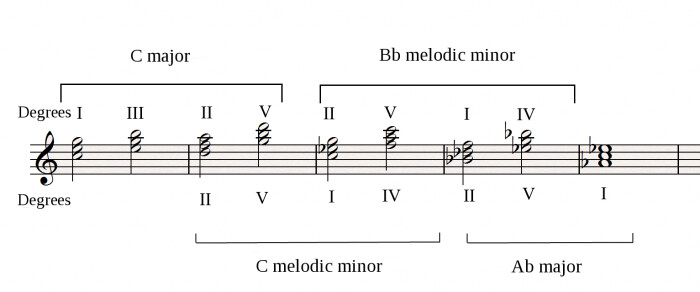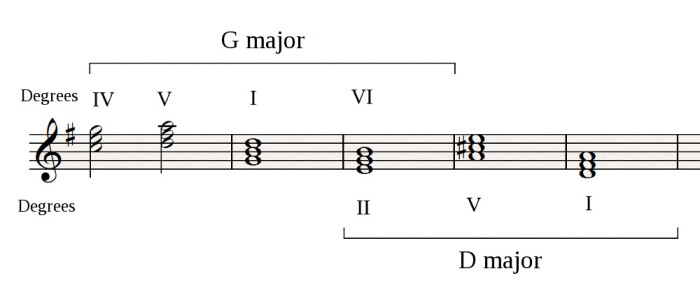In the previous article we saw how to use cadences to modulate to a different key. However, regardless of whether you use a cadence or not, a seamless modulation relies on the so-called pivot chords.
The II-V-I series
II-V-I is a cadence frequently used to modulate. You can actually multiply it endlessly until you reach the tonal center you’re looking for. I’ll show you how.
In the following example, I’m trying to modulate from C major to Ab minor. To achieve that, I’ll go through three “II-V-I” cadences:

For this specific modulation you should know that the I degree of the “II-V-I” cadence is in fact the II degree of the following one. This means that the chords will always be minor. The final I degree can either be minor or major, depending on the effect you are looking for. Every “II-V” half cadence is considered a transitional movement since the only true modulation is to the final key.
In the example the half cadence in the middle is only a transition. So be careful to not consider these alterations as characteristic notes (refer to the previous article) of the final key (I know, it sounds logical, but…). This form of modulation demonstrates, as if it were even necessary at this point, how important the circle of fifths (see article 3) is in the Western tonal system.
Pivot chords
And this brings us to the so-called pivot chords. The what? Pivot chords are chords that belong to different keys and, thus, can be easily used to modulate between keys. As you have probably noticed, the previous example is full of such chords. Hence, for instance, D minor and G minor of the first “II-V” cadence obviously belong to the C major scale (the original key of the song), but also to C melodic minor, the key of the following I degree, which is in turn the second degree of the following Bb minor scale, which is at the same time the second degree of Ab major, the tonic of the final key. Do you follow?
Here’s a simpler example, where I modulate from G major to D major:

The E minor chord of the third bar belongs to both keys: it is the sixth degree of the first one and the second degree of the destination key. So it’s a pivot chord. Do note that it’s not necessary for a pivot chord to be a dominant chord.
What effect does a pivot chord have on your ears? As I’ve mentioned before, your ears determine the key depending on the diatonic environment of the song. In other words, your ear will take the pivot chord as a chord belonging to the initial key. Once the modulation has taken place, it will reinterpret the chord’s place according to the new key.
Join me next time to continue discussing modulation.


